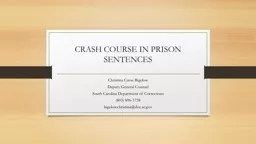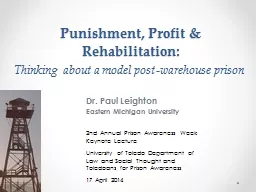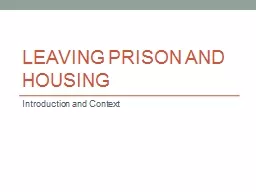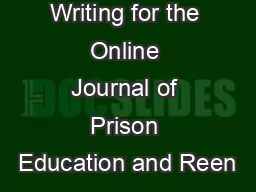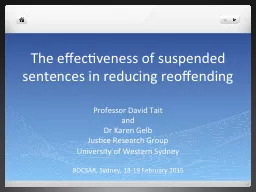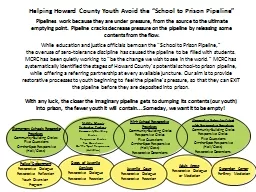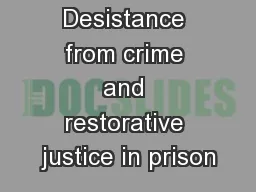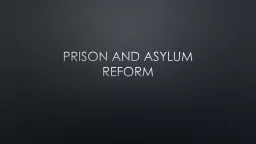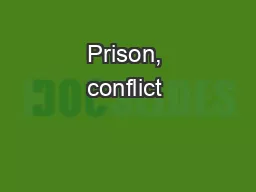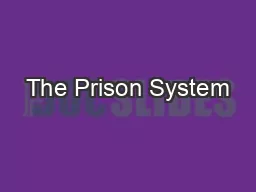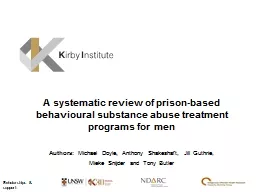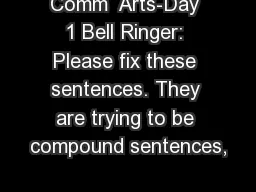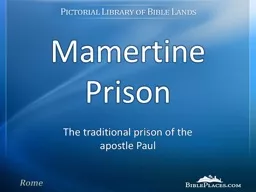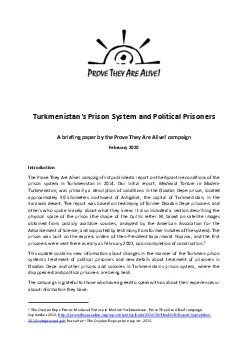PPT-BRIEF OVERVIEW OF PRISON SENTENCES
Author : aaron | Published Date : 2019-06-29
Christina Catoe Bigelow Deputy General Counsel South Carolina Department of Corrections 803 8961738 b igelowchristinadocscgov Basic Background Info about SCDC
Presentation Embed Code
Download Presentation
Download Presentation The PPT/PDF document "BRIEF OVERVIEW OF PRISON SENTENCES" is the property of its rightful owner. Permission is granted to download and print the materials on this website for personal, non-commercial use only, and to display it on your personal computer provided you do not modify the materials and that you retain all copyright notices contained in the materials. By downloading content from our website, you accept the terms of this agreement.
BRIEF OVERVIEW OF PRISON SENTENCES: Transcript
Christina Catoe Bigelow Deputy General Counsel South Carolina Department of Corrections 803 8961738 b igelowchristinadocscgov Basic Background Info about SCDC SCDC currently has 21 institutions. The Hon Justice Gita . Mittal. Title1. Title 2. Women in Prison. The marginalisation and discrimination experienced by women in society does not stop at the prison entrance. Rather it continues to impinge on their lives even when in state custody, perhaps in its most aggravated forms. . Dr. Paul Leighton. Eastern Michigan University. 2nd Annual Prison Awareness Week Keynote . Lecture . University of Toledo Department . of Law and Social Thought and . Toledoans. for Prison . Awareness . Introduction and Context. Key Statistics. Ministry of Justice found that 15% of prisoners had no accommodation prior to imprisonment. One third say they have nowhere to go on leaving prison. 79% of prisoners who were homeless before custody re-offend within one year; 47% of those who were not homeless. . European Prison Education Association Meeting. October 3, 2015. Arve. . Asbjørsen. , PhD. Cormac. Behan, PhD. Ginger Marie Walker, MFA. William . Muth. , PhD. To introduce the journal and assist practitioners with strategies for getting their papers published.. Professor David . Tait. and. Dr. Karen Gelb. Justice Research Group. University of Western Sydney. BOCSAR, Sydney, 18-19 February 2015. Overview. W. hat’s happening in criminal justice policy?. What do we know about reoffending?. Pipelines work because they are under pressure, from the source to the ultimate emptying point. Pipeline cracks decrease pressure on the pipeline by releasing some contents from the flow.. While education and justice officials bemoan the “School to Prison Pipeline,”. Preliminary research results and reflections. Dr. Bart Claes. University of Sheffield. COMBINING (New) directions in research on:. . Restorative Justice: . Focus on the social and moral rehabilitation. Prisons and Asylums. In early . American there . were few prisons . or . asylums.. Asylum- . is an institution offering shelter and support to people who are . mentally ill.. In 1700 if you were caught stealing you would have been publicly . Dr Michelle Butler. 15. th. October 2014. Queen’s University Belfast. Prison. Prison culture shaped through an interaction . of:. Unique . characteristics of the prison environment (Sykes, 1958 – deprivation model) . An Introduction. Thoughts on . Crime, Prison, and Justice. “’The law isn’t always about truth,’” a friend tells Luis J. Rodriguez in his memoir . Always Running. (Rodriguez 192).. Thoughts on Crime, Prison, and Justice. Authors: . Michael Doyle. , . Anthony Shakeshaft, Jill Guthrie, . Mieke Snijder and Tony Butler . Scholarships & support. : . Background . – PhD . Chapter one . - Introduction . and background. mins. ) Please write your responses in your composition book.. 1. I went to the mall, for I bought a lot of shoes.. 2. I love to eat cake, and I do not like icing.. 3. You shouldn’t skip breakfast, so should you skip lunch.. Arch of Septimius Severus with . Mamertine. Prison. Mamertine. Prison building. Mamertine Prison building. Mamertine Prison building, San Giuseppe dei Falegnami. Mamertine Prison building facade. Mamertine Prison exterior. ersA briefingpaper by the Prove They Are Alive campaignFebruary 2020IntroductionThe Prove They Are Alive campaign first published a report on the Byzantine conditions of the prison system in Turkmenis
Download Document
Here is the link to download the presentation.
"BRIEF OVERVIEW OF PRISON SENTENCES"The content belongs to its owner. You may download and print it for personal use, without modification, and keep all copyright notices. By downloading, you agree to these terms.
Related Documents

